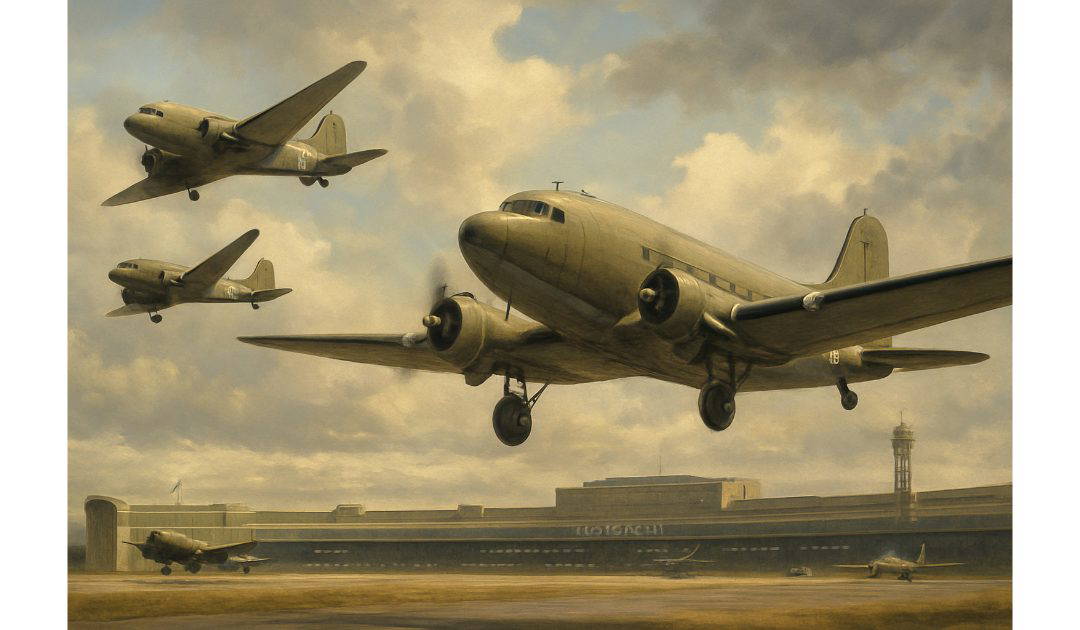I’m currently reading The Spy Who Came in from the Cold. I posted about A Legacy of Spies some time ago, and I finally decided that it was time to read all of John Le Carré’s Smiley series in order. So it seems appropriate that today’s post should be about the Berlin Airlift, since East Berlin is where the start of the book is set.
The Berlin Airlift (1948-1949) is one of the most remarkable humanitarian and logistical operations in modern history. Occurring in the early stages of the Cold War, it was a response to the Soviet Union’s blockade of West Berlin, a city that became a symbol of ideological conflict between East and West.
After Germany’s defeat in World War II, the country was divided into four occupational zones controlled by the United States, the United Kingdom, France, and the Soviet Union. Berlin, although located deep within the Soviet zone, was similarly divided. The Western Allies administered West Berlin, while the Soviets oversaw East Berlin.
Tensions between the Soviet Union and its former allies escalated as ideological differences became more pronounced. The Soviets, seeking to consolidate their influence in Eastern Europe, viewed the economic recovery and political integration of West Germany with suspicion. In response to the introduction of a new currency, the Deutsche Mark, in West Berlin and West Germany—a move designed to stabilise the economy—the Soviets began a blockade on the 24th of June, 1948. They severed all rail, road, and canal links to West Berlin, aiming to force the Western Allies out of the city by starving it of essential supplies.
Faced with a dire situation, the Western Allies had two options: withdraw from Berlin or find a way to support its residents. Choosing the latter, they launched the Berlin Airlift, codenamed “Operation Vittles” by the Americans and “Operation Plainfare” by the British.
The operation commenced on the 26th of June 26, 1948. The Allies utilised three air corridors agreed upon in post-war negotiations, flying from West Germany into Berlin’s Tempelhof, Gatow, and later Tegel airports. The logistical challenge was immense. West Berlin required around 4,500 tonnes of supplies daily, including food, fuel, medicine, and coal.
The initial phase of the airlift faced numerous hurdles. Aircraft shortages, limited airport capacity, and adverse weather conditions complicated efforts. However, under the leadership of figures like U.S. General Lucius D. Clay and British Air Commodore Reginald Waite, operations became more efficient.
The U.S. used C-47 Skytrains and later the larger C-54 Skymasters, while the British employed Avro Yorks and Handley Page Haltons. Pilots flew around the clock, navigating narrow air corridors and often landing at intervals as short as three minutes. Maintenance crews worked tirelessly to keep aircraft operational.
One innovative solution was the construction of Tegel Airport in the French sector of Berlin, completed in an astonishing 90 days. This additional airfield significantly increased the operation’s capacity.
The Berlin Airlift was not just a logistical triumph; it was a profound humanitarian effort. Over 2.3 million West Berliners relied entirely on the airlift for survival. Supplies included not just food and fuel but also essentials like clothing and medicines.
One of the most heartwarming aspects was “Operation Little Vittles,” initiated by U.S. pilot Gail Halvorsen. He began dropping small parachutes filled with sweets for Berlin’s children, earning the nickname “The Candy Bomber.” This gesture boosted morale and symbolised the solidarity between Berliners and the Allies.
Despite Soviet attempts to disrupt the airlift through intimidation and propaganda, the operation’s success undermined their strategy. The efficiency and determination displayed by the Allies demonstrated their commitment to West Berlin.
By April 1949, the airlift was delivering more cargo than had previously been transported by rail before the blockade. Recognising the futility of their efforts, the Soviets lifted the blockade on May 12, 1949.
The Berlin Airlift continued until the 30th of September, 1949, to build a reserve of supplies. In total, over 277,000 flights delivered around 2.3 million tonnes of goods. Tragically, 101 personnel lost their lives during the operation due to accidents.
The airlift had profound implications. It solidified the division of Germany and Berlin, leading to the establishment of the Federal Republic of Germany (West Germany) and the German Democratic Republic (East Germany). It also marked the first major confrontation of the Cold War, setting the stage for subsequent conflicts and alliances.

